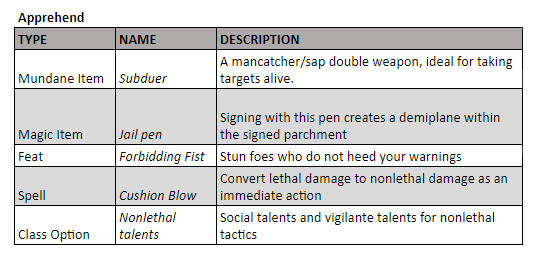In Keyword Design, I use a single word as inspiration for a mundane item, a magic item, a feat, a spell, and a class option. Today’s word is “apprehend” as suggested by Quo.
Today’s keyword immediately reminded me of something Crystal Frasier said in the Cartoons Made Me a Better GM seminar at PaizoCon 2017: Pathfinder penalizes players for using nonlethal damage. And this isn’t an abstract interpretation of the rules. Unless you have an option that negates it, you take a –4 penalty on your attack roll if you use a melee weapon that deals lethal damage to deal nonlethal damage instead.
There are options for dealing nonlethal damage -actually buying a weapon that deals nonlethal damage, being a monk, certain weapon properties- but once you have an unconscious enemy, what do you do with it? Your mercy becomes your burden. With that in mind, here are some options for apprehending in Pathfinder.
New Mundane Items
SUBDUER
Cost: 150 gp
Damage: 1d4 (Small), 1d6 (Medium), Type: P
Weight: 10 lbs.
Special: grapple, nonlethal, reach
DESCRIPTION
A subduer is an advanced mancatcher built to capture creatures of more varied size categories. It’s four asymetrical mandibles are designed to wrap around a humanoid’s arms as well as clamp over one shoulder and under the opposite armpit. A tightly wound rope feeds from the tip of each mandible into a single winch by the hilt.
Make an attack like with a mancatcher. If the target is a different size than the attacker, the attacker can make a grapplecheck to slack or tighten the winch. A successful grapple check adjusts the subduer one size category in the appropriate direction, plus one size category for every 5 by which the check exceeds the target’s CMD.
Once the target is grappled and the subduer set to the appropriate size, the attacker can perform a move or damage grapple action against him, although the damage action only deals nonlethal damage. Additionally, the grappler can perform the Tie Up action, even if the target isn’t pinned. This involves tightening the winch and locking it. Unlocking a locked subduer requires a full round action by a creature other that the target of the subduer.
Weapon Feature(s): grapple, nonlethal, reach
When I started roleplaying with D&D 2nd edition, there were hardcovers and there were softcovers, and the softcovers were magical. Player focused softcovers (called Player’s Handbook Rules Supplements) were brown with golden text and no image and had titles like The Complete Fighter’s Guide. It was in that Fighter’s Guide that I was introduced to the mancatcher, a weapon He-Man-esq in its absurdity and name. Of course I was delighted that it was ported over to Pathfinder, but the translation wasn’t ideal. The attacker needs to hold onto the mancatcher with both hands to keep the man caught. That takes both people out of the action, a net gain of 0. It’s worse than just tying him up. Plus you have to buy your mancatcher based on the size of your target, something you can’t know ahead of time.
The subduer is a better mousetrap.
New Magic Item
JAIL PEN
Aura strong conjuratioon; CL 15th; Slot -; Price 12 000 gp; Weight –
DESCRIPTION
A feather quill punctures a glass chamber, automatically funneling the ink held within at a steady pace when uncapped. When a user speaks a command word, the jail pen activates. If the user spends 4 hours writing and signing a confession of their own free will, the glass chamber becomes a temporary demiplane, which the user is shifted into. The demiplane is large enough to fit the user comfortably, providing them with basic food and water to survive. They remain there for 15 days or until their confession is signed again by an individual designated in the contract.
A jail pen can only house one creature at a time, but that creature can be any size. If an illiterate creature wishes to confess but can’t write a confession, a surrogate can scribe the confession dictated to them as long as the confession is signed by the appropriate person.
CONSTRUCTION REQUIREMENTS
Craft Wondrous Item, create demiplane, create food and water; Cost 6000 gp
In philosophy, the prisoner’s dilemma is a scenario in which choosing to confess to a crime will either exonerate you of that crime or render you guilty, depending on the choice of someone else in the same situation whose decision is outside of your control. In Pathfinder, the prisoner dilemma is “why do we do when we show an opponent mercy?” Prisoners are a liability in Pathfinder. You don’t know if you can trust them, they require actions to manage, and can throw off a timeline. Even when it’s the good, heroic thing to do, and being good means making sacrifices, the player should not be sacrificing their fun to do the right thing. So, the jail pen! I like it because 1. Pun name! 2. It makes pocket prisoners.
As usual, I use the magic item creation rules to ballpark the price, but I find the final price prohibitively expensive. It could have been an expendable item for 6000 gp, or 144 000 gp for a command word activated item as described above. Because of how long it takes to write a confession (the casting time of create demiplane) and because the confession must be done willingly, I feel 12 000 gp is much more reasonable.
New Feat
FORBIDDING FIST(General)
Your stunning blows are contingent on your foe’s behavior.
Prerequisites: Dex 13, Wis 15, Improved Unarmed Strike, Stunning Fist, base attack bonus +10 or monk level 10.
Benefit: This feat functions like Stunning Fist, but your target is only stunned if they perform a specific action on their turn. When you use Forbidding Fist, choose an action outlined in the spell forbid action. They are forbidden from performing that action for a number of rounds equal to your Wisdom modifier. Any time the target attempts the forbidden action before the duration expires, they must make a Fortitude saving throw (DC 10 + 1/2 your character level + your Wis modifier) or be stunned for 1 round. The target is not aware of the action they are forbidden from using unless they are told or until they attempt to perform the action. Rounds the target is stunned do not count against the duration of the feat. Using Forbidding Fist spends a use of your Stunning Fist.
You know when you set out to make the Vulcan nerve pinch and then realize that it is basically Stunning Fist and is already a core part of the game? Well, you just gotta make do.
New Spell
Cushion Light Blow
School conjuration (healing); Level cleric/oracle 2, druid 2, paladin 2, shaman 2
CASTING
Casting Time 1 immediate action
Components V, S
EFFECT
Range close (25 ft. + 5 ft./2 levels)
Target dead or dying creature
Duration instantaneous
Saving Throw none; Spell Resistance no
DESCRIPTION
This spell potentially stabilizes a target reduced to negative hit points by lethal damage. Cushion blow converts 1d8 points of damage + 1 point per caster level (maximum +5) to nonlethal damage. The amount of damage converted to nonlethal damage cannot exceed the amount of damage that reduced the target to negative hit points. For example, if a target with 10 Con is at 10 hp and is dealt 9 damage and 11 damage from a pair of claw attacks, cushion blow cannot convert more than 11 damage to nonlethal damage.
Cushion Moderate Blow
School conjuration (healing); Level cleric/oracle 4, druid 4, paladin 4, shaman 4
DESCRIPTION
This spell functions like cushion light blow, except that it converts 2d8 points of damage + 1 point per caster level (maximum +10) to nonlethal damage.
Cushion Serious Blow
School conjuration (healing); Level cleric/oracle 6, druid 6, shaman 6
DESCRIPTION
This spell functions like cushion light blow, except that it converts 3d8 points of damage + 1 point per caster level (maximum +15) to nonlethal damage.
Cushion Critical Blow
School conjuration (healing); Level cleric/oracle 8, druid 8
DESCRIPTION
This spell functions like cushion light blow, except that it converts 4d8 points of damage + 1 point per caster level (maximum +20) to nonlethal damage.
Breathe of life is such an important spell, and there’s no minor version of it. The cushion blow spells not only prevent allies from dying, they can prevent allies from killing.
New Class Option
NEW SOCIAL TALENTS AND VIGILANTE TALENTS
Some vigilantes believe that with the power granted by the mask they wear comes the responsibility to take care of others, even those they fight against. The following are new social talents and vigilante talents ideal for vigilantes with a no-kill rule.
SOCIAL TALENTS
Advocation Insight: When in their social identity and officially representing the interests of someone the vigilante has experience dealing with in their vigilante identity, the vigilante gains a +4 insight bonus on relevent skill checks. For example, the vigilante would get a +4 bonus to Bluff or Profession (lawyer) skill checks in a courtroom, or a +4 bonus on Diplomacy or Knowledge (nobility) skill checks in a royal deposition.
Outreach Program: The vigilante can use his influence to help the less fortunate explore options their upbringing would otherwise make inaccessible to them. Beneficiaries share a pool of virtual gold pieces equal to 150 gp plus 10 gp per class level to spend on services and non-material goods. This pool replenishes at the beginning of every month.This charity program is centered in his area of renown, and he can change it every time he changes his area of renown. When in this area of renown, the vigilanted gains followers, as the Leadership feat, as though he had a leadership score equal to his class level. If he also or later gains the Leadership feat, the followers granted by this talent are in addition to followers granted by the Leadership feat. A vigilante must be at least 7th level and have the renown social talent to select this talent.
VIGILANTE TALENTS
Smoke Out: When a vigilante would normally deal fire damage, he can instead choose to deal nonlethal damage and perform a dirty trick combat maneuver as a move action, even if the target is not in reach.
Subdual Assault: Once per day as a move action, the vigilante can coordinate his allies to use nonlethal means of defeating enemies for 1 round. Allies within 30 feet of the vigilante do not take a penalty when making nonlethal melee attacks with lethal melee weapons. Any allies who do not deal lethal damage before the beginning of the vigilante’s next turn -including the vigilante himself- can choose a bonuses for that round at the beginning of their turn as though the vigilante had cast blessing of fervor. At 7th level and every 3 levels thereafter, the vigilante gains an additional use of this ability. A vigilante must be at least 3rd level to select this talent.
Taze: When a vigilante would normally deal electricity damage, he can instead choose to deal nonlethal damage and perform a trip combat maneuver as a swift action, even if the target is not in reach.
I know a lot of super heroes have no killing rules, but the first ones I think of are Daredevil and Batman. The Trial of the Incredible Hulk got me into comics, Daredevil specifically, and I guess it was just a phase in the Daredevil comics where he was only a vigilante to support his cases as a lawyer. Since you can’t prosecute a dead defendant, Daredevil did everything he could to keep his enemies alive.
Batman is more famous for his no kill rule, but Bruce Wayne also helps with the Wayne Foundation. That was the basis for the Outreach Program social talent. I didn’t need to go into the benefits granted to beneficiaries of the program, but I thought it was a fun way to ground the flavour.
Thanks again to Quo for the keyword suggestion. If you have thoughts on the balance and use of these abilities, or you would like to offer a single word that you think can inspire a mundane item, a magic item, a feat, a spell, and a class option, let me know in the comments below.






absorb